Unilever Case Study: HR Practices and Employee Motivation Analysis
VerifiedAdded on 2023/06/08
|10
|2594
|52
Project
AI Summary
This project proposal investigates the significance of Human Resources (HR) practices on employee motivation within the manufacturing sector, focusing on a case study of Unilever. The company is facing challenges in maintaining employee motivation, which negatively affects overall productivity and profitability. The project aims to conduct an in-depth study of Unilever's HR practices to identify strategies for improving employee motivation. The research will employ a qualitative research approach, utilizing an inductive method and interpretivism philosophy to analyze data collected through interviews with employees and management. Thematic analysis will be used to identify recurring patterns and themes within the data. The project's timeline, key stakeholders, resources, and costs are outlined, with the expected deliverables including insights for strengthening Unilever's approach to employee motivation and providing useful information for other researchers in the field. Desklib provides access to this project and many other solved assignments.

Topic: To assess the significance of HR
practices on employee motivation in
manufacturing sector: A study on Unilever.
Student’s name:
Course name:
Year:
Semester:
Lecturer’s name:
Date of submission:
practices on employee motivation in
manufacturing sector: A study on Unilever.
Student’s name:
Course name:
Year:
Semester:
Lecturer’s name:
Date of submission:
Paraphrase This Document
Need a fresh take? Get an instant paraphrase of this document with our AI Paraphraser

Executive Summary
The project proposal aim is to understand the role of HR practices over the employee
motivation working with the manufacturing sector. The project proposal is based on the Unilever
company. This company is currently experiencing issues in keeping the employees motivated and
enthusiastic to work efficiently towards their job roles. Overall productivity and profitability of the
suffers as an outcome to this. The objective of the project is in depth study of HR practices for
concluding the best way which could solve this issue. This proposal covers the methodologies to be
used for the project and the costs involved throughout. The proposal includes the outcomes that are
expected from project.
The project proposal aim is to understand the role of HR practices over the employee
motivation working with the manufacturing sector. The project proposal is based on the Unilever
company. This company is currently experiencing issues in keeping the employees motivated and
enthusiastic to work efficiently towards their job roles. Overall productivity and profitability of the
suffers as an outcome to this. The objective of the project is in depth study of HR practices for
concluding the best way which could solve this issue. This proposal covers the methodologies to be
used for the project and the costs involved throughout. The proposal includes the outcomes that are
expected from project.
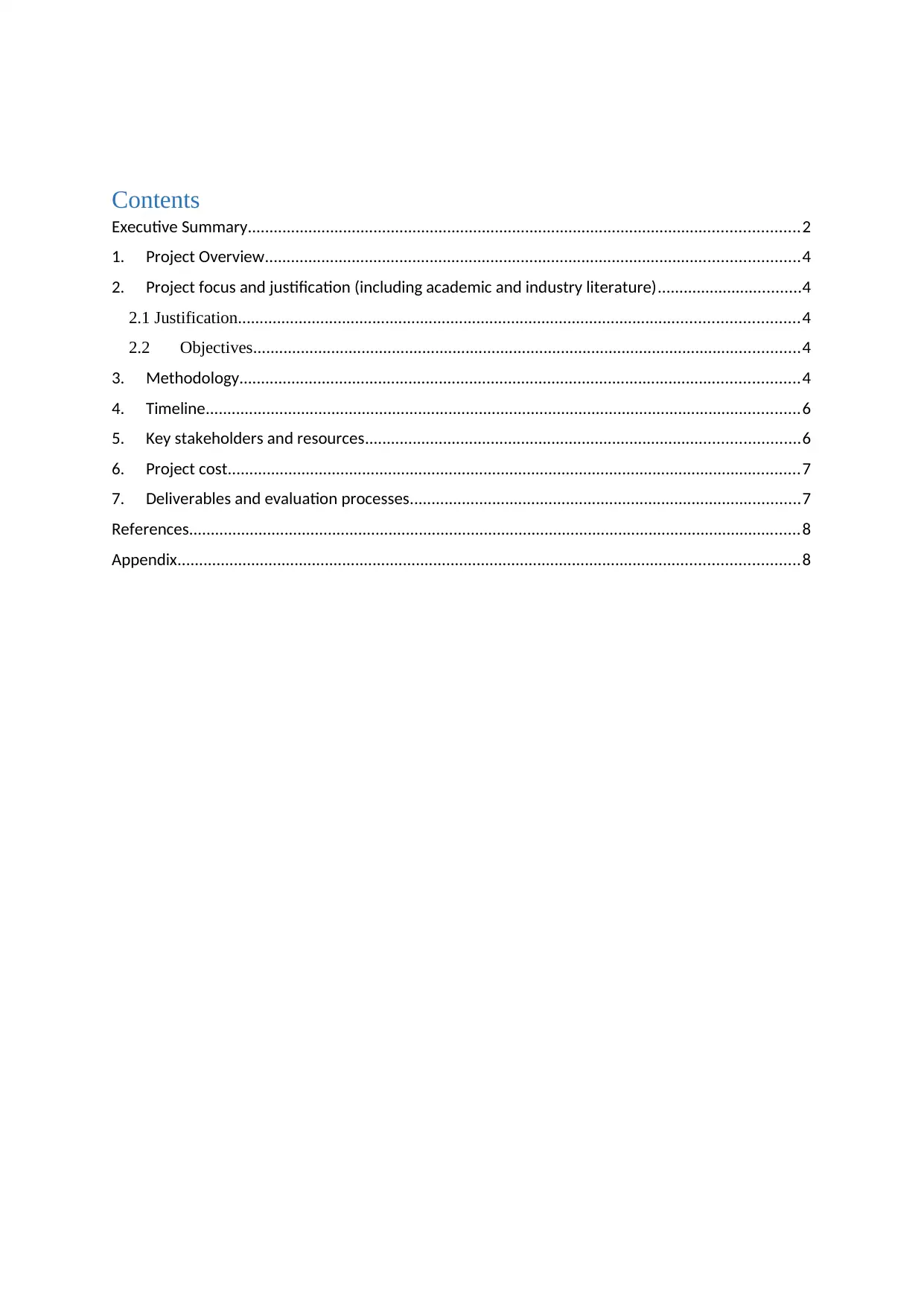
Contents
Executive Summary...............................................................................................................................2
1. Project Overview...........................................................................................................................4
2. Project focus and justification (including academic and industry literature).................................4
2.1 Justification.................................................................................................................................4
2.2 Objectives..............................................................................................................................4
3. Methodology.................................................................................................................................4
4. Timeline.........................................................................................................................................6
5. Key stakeholders and resources....................................................................................................6
6. Project cost....................................................................................................................................7
7. Deliverables and evaluation processes..........................................................................................7
References.............................................................................................................................................8
Appendix...............................................................................................................................................8
Executive Summary...............................................................................................................................2
1. Project Overview...........................................................................................................................4
2. Project focus and justification (including academic and industry literature).................................4
2.1 Justification.................................................................................................................................4
2.2 Objectives..............................................................................................................................4
3. Methodology.................................................................................................................................4
4. Timeline.........................................................................................................................................6
5. Key stakeholders and resources....................................................................................................6
6. Project cost....................................................................................................................................7
7. Deliverables and evaluation processes..........................................................................................7
References.............................................................................................................................................8
Appendix...............................................................................................................................................8
⊘ This is a preview!⊘
Do you want full access?
Subscribe today to unlock all pages.

Trusted by 1+ million students worldwide
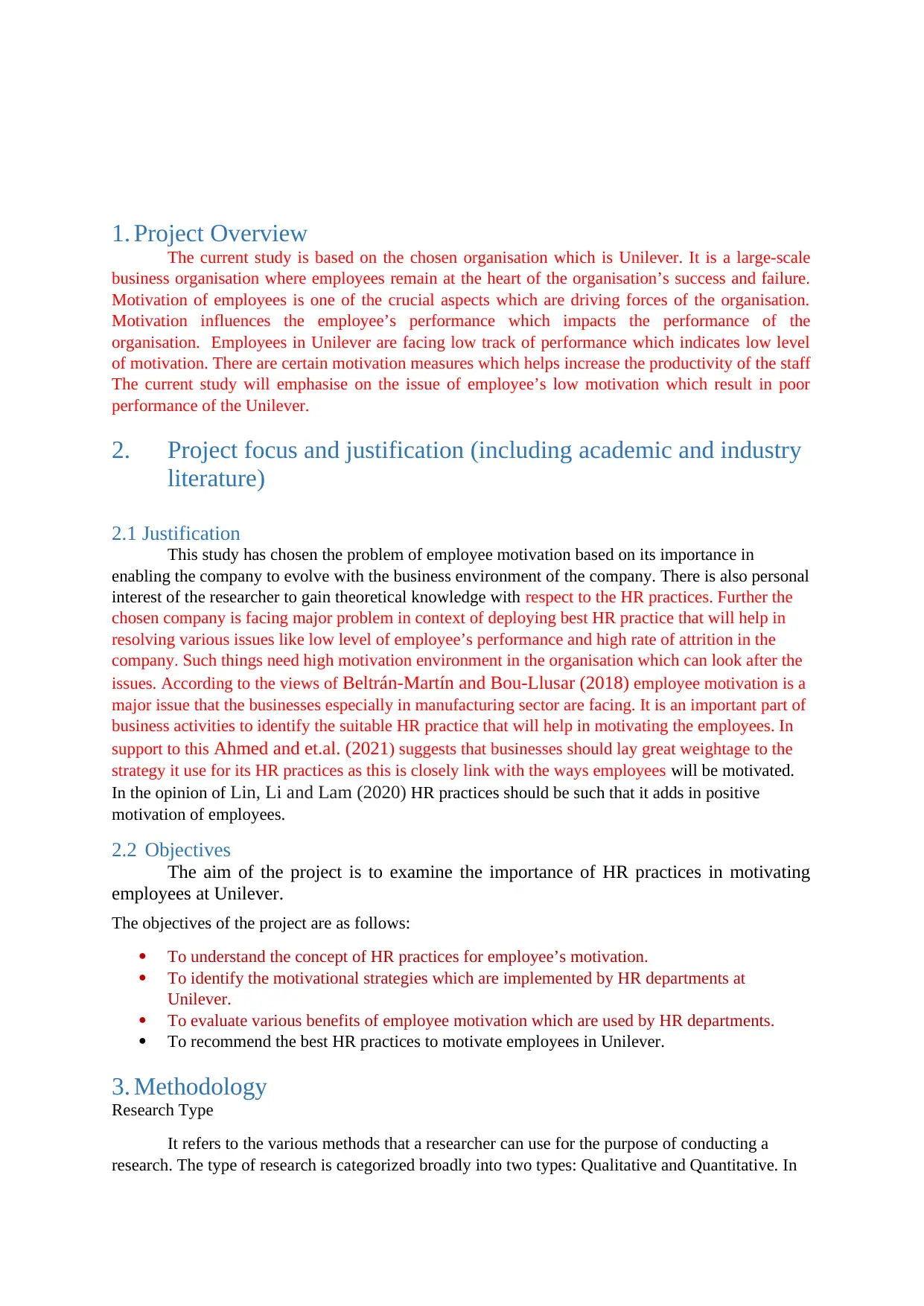
1. Project Overview
The current study is based on the chosen organisation which is Unilever. It is a large-scale
business organisation where employees remain at the heart of the organisation’s success and failure.
Motivation of employees is one of the crucial aspects which are driving forces of the organisation.
Motivation influences the employee’s performance which impacts the performance of the
organisation. Employees in Unilever are facing low track of performance which indicates low level
of motivation. There are certain motivation measures which helps increase the productivity of the staff
The current study will emphasise on the issue of employee’s low motivation which result in poor
performance of the Unilever.
2. Project focus and justification (including academic and industry
literature)
2.1 Justification
This study has chosen the problem of employee motivation based on its importance in
enabling the company to evolve with the business environment of the company. There is also personal
interest of the researcher to gain theoretical knowledge with respect to the HR practices. Further the
chosen company is facing major problem in context of deploying best HR practice that will help in
resolving various issues like low level of employee’s performance and high rate of attrition in the
company. Such things need high motivation environment in the organisation which can look after the
issues. According to the views of Beltrán-Martín and Bou-Llusar (2018) employee motivation is a
major issue that the businesses especially in manufacturing sector are facing. It is an important part of
business activities to identify the suitable HR practice that will help in motivating the employees. In
support to this Ahmed and et.al. (2021) suggests that businesses should lay great weightage to the
strategy it use for its HR practices as this is closely link with the ways employees will be motivated.
In the opinion of Lin, Li and Lam (2020) HR practices should be such that it adds in positive
motivation of employees.
2.2 Objectives
The aim of the project is to examine the importance of HR practices in motivating
employees at Unilever.
The objectives of the project are as follows:
To understand the concept of HR practices for employee’s motivation.
To identify the motivational strategies which are implemented by HR departments at
Unilever.
To evaluate various benefits of employee motivation which are used by HR departments.
To recommend the best HR practices to motivate employees in Unilever.
3. Methodology
Research Type
It refers to the various methods that a researcher can use for the purpose of conducting a
research. The type of research is categorized broadly into two types: Qualitative and Quantitative. In
The current study is based on the chosen organisation which is Unilever. It is a large-scale
business organisation where employees remain at the heart of the organisation’s success and failure.
Motivation of employees is one of the crucial aspects which are driving forces of the organisation.
Motivation influences the employee’s performance which impacts the performance of the
organisation. Employees in Unilever are facing low track of performance which indicates low level
of motivation. There are certain motivation measures which helps increase the productivity of the staff
The current study will emphasise on the issue of employee’s low motivation which result in poor
performance of the Unilever.
2. Project focus and justification (including academic and industry
literature)
2.1 Justification
This study has chosen the problem of employee motivation based on its importance in
enabling the company to evolve with the business environment of the company. There is also personal
interest of the researcher to gain theoretical knowledge with respect to the HR practices. Further the
chosen company is facing major problem in context of deploying best HR practice that will help in
resolving various issues like low level of employee’s performance and high rate of attrition in the
company. Such things need high motivation environment in the organisation which can look after the
issues. According to the views of Beltrán-Martín and Bou-Llusar (2018) employee motivation is a
major issue that the businesses especially in manufacturing sector are facing. It is an important part of
business activities to identify the suitable HR practice that will help in motivating the employees. In
support to this Ahmed and et.al. (2021) suggests that businesses should lay great weightage to the
strategy it use for its HR practices as this is closely link with the ways employees will be motivated.
In the opinion of Lin, Li and Lam (2020) HR practices should be such that it adds in positive
motivation of employees.
2.2 Objectives
The aim of the project is to examine the importance of HR practices in motivating
employees at Unilever.
The objectives of the project are as follows:
To understand the concept of HR practices for employee’s motivation.
To identify the motivational strategies which are implemented by HR departments at
Unilever.
To evaluate various benefits of employee motivation which are used by HR departments.
To recommend the best HR practices to motivate employees in Unilever.
3. Methodology
Research Type
It refers to the various methods that a researcher can use for the purpose of conducting a
research. The type of research is categorized broadly into two types: Qualitative and Quantitative. In
Paraphrase This Document
Need a fresh take? Get an instant paraphrase of this document with our AI Paraphraser
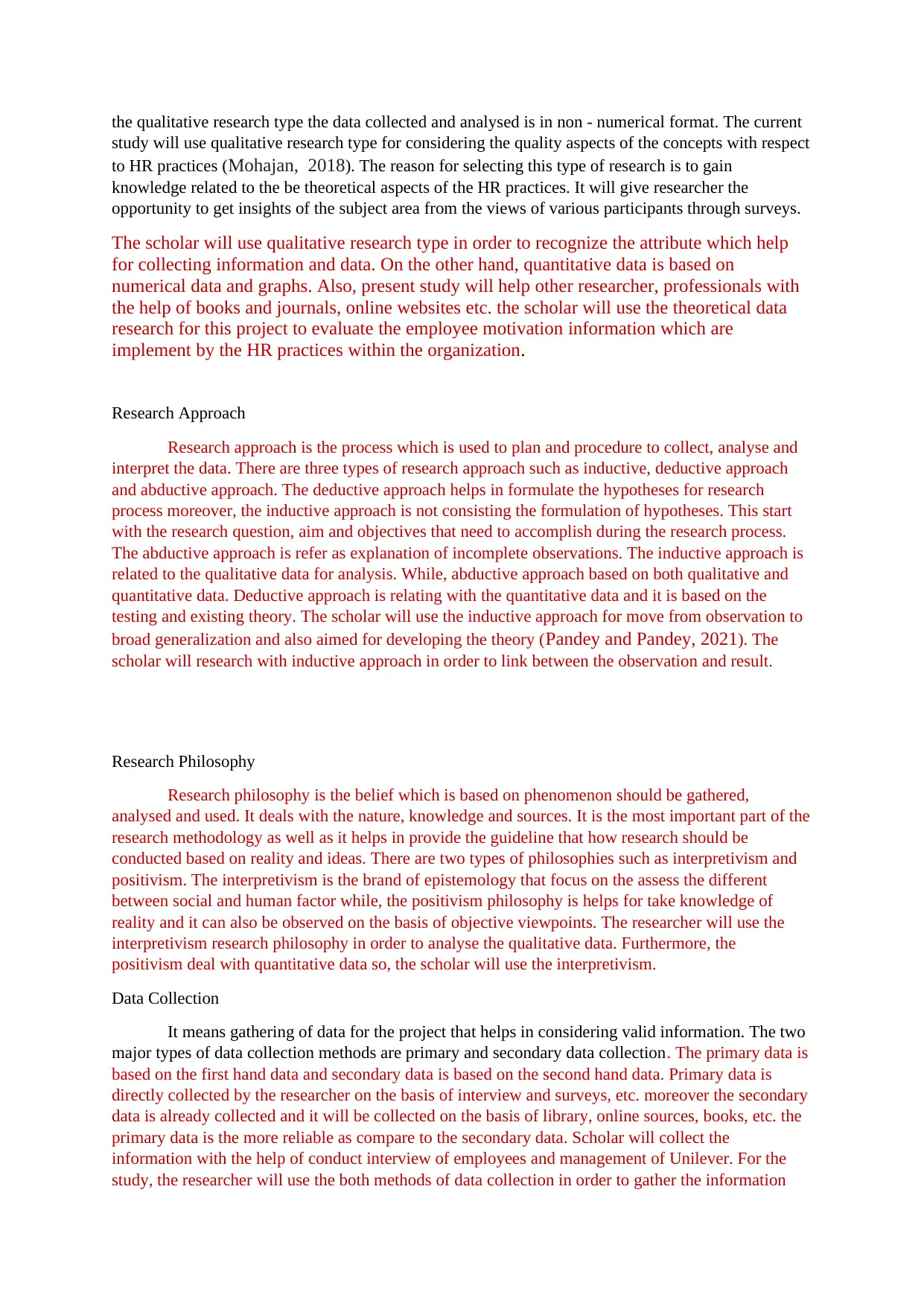
the qualitative research type the data collected and analysed is in non - numerical format. The current
study will use qualitative research type for considering the quality aspects of the concepts with respect
to HR practices (Mohajan, 2018). The reason for selecting this type of research is to gain
knowledge related to the be theoretical aspects of the HR practices. It will give researcher the
opportunity to get insights of the subject area from the views of various participants through surveys.
The scholar will use qualitative research type in order to recognize the attribute which help
for collecting information and data. On the other hand, quantitative data is based on
numerical data and graphs. Also, present study will help other researcher, professionals with
the help of books and journals, online websites etc. the scholar will use the theoretical data
research for this project to evaluate the employee motivation information which are
implement by the HR practices within the organization.
Research Approach
Research approach is the process which is used to plan and procedure to collect, analyse and
interpret the data. There are three types of research approach such as inductive, deductive approach
and abductive approach. The deductive approach helps in formulate the hypotheses for research
process moreover, the inductive approach is not consisting the formulation of hypotheses. This start
with the research question, aim and objectives that need to accomplish during the research process.
The abductive approach is refer as explanation of incomplete observations. The inductive approach is
related to the qualitative data for analysis. While, abductive approach based on both qualitative and
quantitative data. Deductive approach is relating with the quantitative data and it is based on the
testing and existing theory. The scholar will use the inductive approach for move from observation to
broad generalization and also aimed for developing the theory (Pandey and Pandey, 2021). The
scholar will research with inductive approach in order to link between the observation and result.
Research Philosophy
Research philosophy is the belief which is based on phenomenon should be gathered,
analysed and used. It deals with the nature, knowledge and sources. It is the most important part of the
research methodology as well as it helps in provide the guideline that how research should be
conducted based on reality and ideas. There are two types of philosophies such as interpretivism and
positivism. The interpretivism is the brand of epistemology that focus on the assess the different
between social and human factor while, the positivism philosophy is helps for take knowledge of
reality and it can also be observed on the basis of objective viewpoints. The researcher will use the
interpretivism research philosophy in order to analyse the qualitative data. Furthermore, the
positivism deal with quantitative data so, the scholar will use the interpretivism.
Data Collection
It means gathering of data for the project that helps in considering valid information. The two
major types of data collection methods are primary and secondary data collection. The primary data is
based on the first hand data and secondary data is based on the second hand data. Primary data is
directly collected by the researcher on the basis of interview and surveys, etc. moreover the secondary
data is already collected and it will be collected on the basis of library, online sources, books, etc. the
primary data is the more reliable as compare to the secondary data. Scholar will collect the
information with the help of conduct interview of employees and management of Unilever. For the
study, the researcher will use the both methods of data collection in order to gather the information
study will use qualitative research type for considering the quality aspects of the concepts with respect
to HR practices (Mohajan, 2018). The reason for selecting this type of research is to gain
knowledge related to the be theoretical aspects of the HR practices. It will give researcher the
opportunity to get insights of the subject area from the views of various participants through surveys.
The scholar will use qualitative research type in order to recognize the attribute which help
for collecting information and data. On the other hand, quantitative data is based on
numerical data and graphs. Also, present study will help other researcher, professionals with
the help of books and journals, online websites etc. the scholar will use the theoretical data
research for this project to evaluate the employee motivation information which are
implement by the HR practices within the organization.
Research Approach
Research approach is the process which is used to plan and procedure to collect, analyse and
interpret the data. There are three types of research approach such as inductive, deductive approach
and abductive approach. The deductive approach helps in formulate the hypotheses for research
process moreover, the inductive approach is not consisting the formulation of hypotheses. This start
with the research question, aim and objectives that need to accomplish during the research process.
The abductive approach is refer as explanation of incomplete observations. The inductive approach is
related to the qualitative data for analysis. While, abductive approach based on both qualitative and
quantitative data. Deductive approach is relating with the quantitative data and it is based on the
testing and existing theory. The scholar will use the inductive approach for move from observation to
broad generalization and also aimed for developing the theory (Pandey and Pandey, 2021). The
scholar will research with inductive approach in order to link between the observation and result.
Research Philosophy
Research philosophy is the belief which is based on phenomenon should be gathered,
analysed and used. It deals with the nature, knowledge and sources. It is the most important part of the
research methodology as well as it helps in provide the guideline that how research should be
conducted based on reality and ideas. There are two types of philosophies such as interpretivism and
positivism. The interpretivism is the brand of epistemology that focus on the assess the different
between social and human factor while, the positivism philosophy is helps for take knowledge of
reality and it can also be observed on the basis of objective viewpoints. The researcher will use the
interpretivism research philosophy in order to analyse the qualitative data. Furthermore, the
positivism deal with quantitative data so, the scholar will use the interpretivism.
Data Collection
It means gathering of data for the project that helps in considering valid information. The two
major types of data collection methods are primary and secondary data collection. The primary data is
based on the first hand data and secondary data is based on the second hand data. Primary data is
directly collected by the researcher on the basis of interview and surveys, etc. moreover the secondary
data is already collected and it will be collected on the basis of library, online sources, books, etc. the
primary data is the more reliable as compare to the secondary data. Scholar will collect the
information with the help of conduct interview of employees and management of Unilever. For the
study, the researcher will use the both methods of data collection in order to gather the information
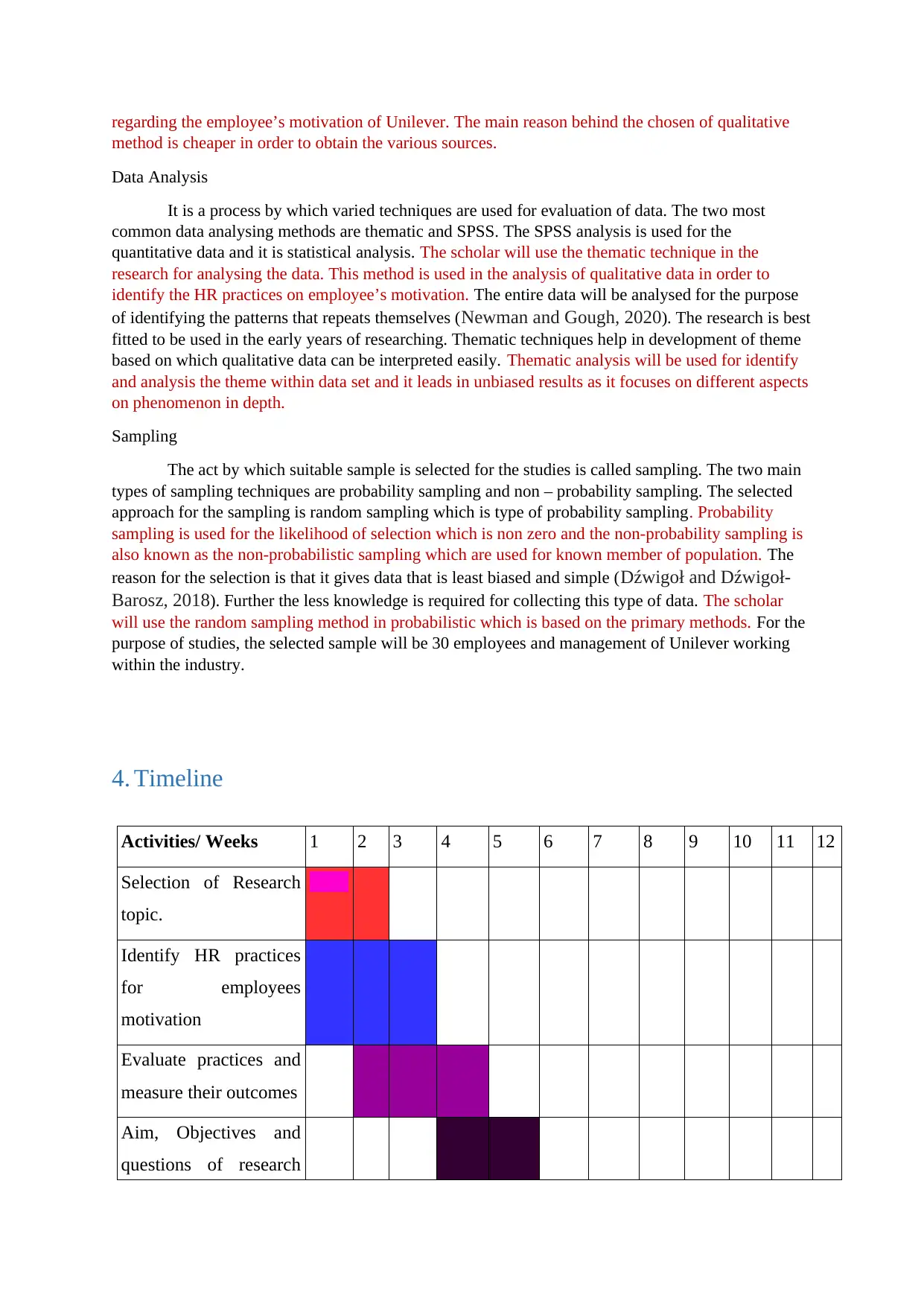
regarding the employee’s motivation of Unilever. The main reason behind the chosen of qualitative
method is cheaper in order to obtain the various sources.
Data Analysis
It is a process by which varied techniques are used for evaluation of data. The two most
common data analysing methods are thematic and SPSS. The SPSS analysis is used for the
quantitative data and it is statistical analysis. The scholar will use the thematic technique in the
research for analysing the data. This method is used in the analysis of qualitative data in order to
identify the HR practices on employee’s motivation. The entire data will be analysed for the purpose
of identifying the patterns that repeats themselves (Newman and Gough, 2020). The research is best
fitted to be used in the early years of researching. Thematic techniques help in development of theme
based on which qualitative data can be interpreted easily. Thematic analysis will be used for identify
and analysis the theme within data set and it leads in unbiased results as it focuses on different aspects
on phenomenon in depth.
Sampling
The act by which suitable sample is selected for the studies is called sampling. The two main
types of sampling techniques are probability sampling and non – probability sampling. The selected
approach for the sampling is random sampling which is type of probability sampling. Probability
sampling is used for the likelihood of selection which is non zero and the non-probability sampling is
also known as the non-probabilistic sampling which are used for known member of population. The
reason for the selection is that it gives data that is least biased and simple (Dźwigoł and Dźwigoł-
Barosz, 2018). Further the less knowledge is required for collecting this type of data. The scholar
will use the random sampling method in probabilistic which is based on the primary methods. For the
purpose of studies, the selected sample will be 30 employees and management of Unilever working
within the industry.
4. Timeline
Activities/ Weeks 1 2 3 4 5 6 7 8 9 10 11 12
Selection of Research
topic.
Identify HR practices
for employees
motivation
Evaluate practices and
measure their outcomes
Aim, Objectives and
questions of research
method is cheaper in order to obtain the various sources.
Data Analysis
It is a process by which varied techniques are used for evaluation of data. The two most
common data analysing methods are thematic and SPSS. The SPSS analysis is used for the
quantitative data and it is statistical analysis. The scholar will use the thematic technique in the
research for analysing the data. This method is used in the analysis of qualitative data in order to
identify the HR practices on employee’s motivation. The entire data will be analysed for the purpose
of identifying the patterns that repeats themselves (Newman and Gough, 2020). The research is best
fitted to be used in the early years of researching. Thematic techniques help in development of theme
based on which qualitative data can be interpreted easily. Thematic analysis will be used for identify
and analysis the theme within data set and it leads in unbiased results as it focuses on different aspects
on phenomenon in depth.
Sampling
The act by which suitable sample is selected for the studies is called sampling. The two main
types of sampling techniques are probability sampling and non – probability sampling. The selected
approach for the sampling is random sampling which is type of probability sampling. Probability
sampling is used for the likelihood of selection which is non zero and the non-probability sampling is
also known as the non-probabilistic sampling which are used for known member of population. The
reason for the selection is that it gives data that is least biased and simple (Dźwigoł and Dźwigoł-
Barosz, 2018). Further the less knowledge is required for collecting this type of data. The scholar
will use the random sampling method in probabilistic which is based on the primary methods. For the
purpose of studies, the selected sample will be 30 employees and management of Unilever working
within the industry.
4. Timeline
Activities/ Weeks 1 2 3 4 5 6 7 8 9 10 11 12
Selection of Research
topic.
Identify HR practices
for employees
motivation
Evaluate practices and
measure their outcomes
Aim, Objectives and
questions of research
⊘ This is a preview!⊘
Do you want full access?
Subscribe today to unlock all pages.

Trusted by 1+ million students worldwide
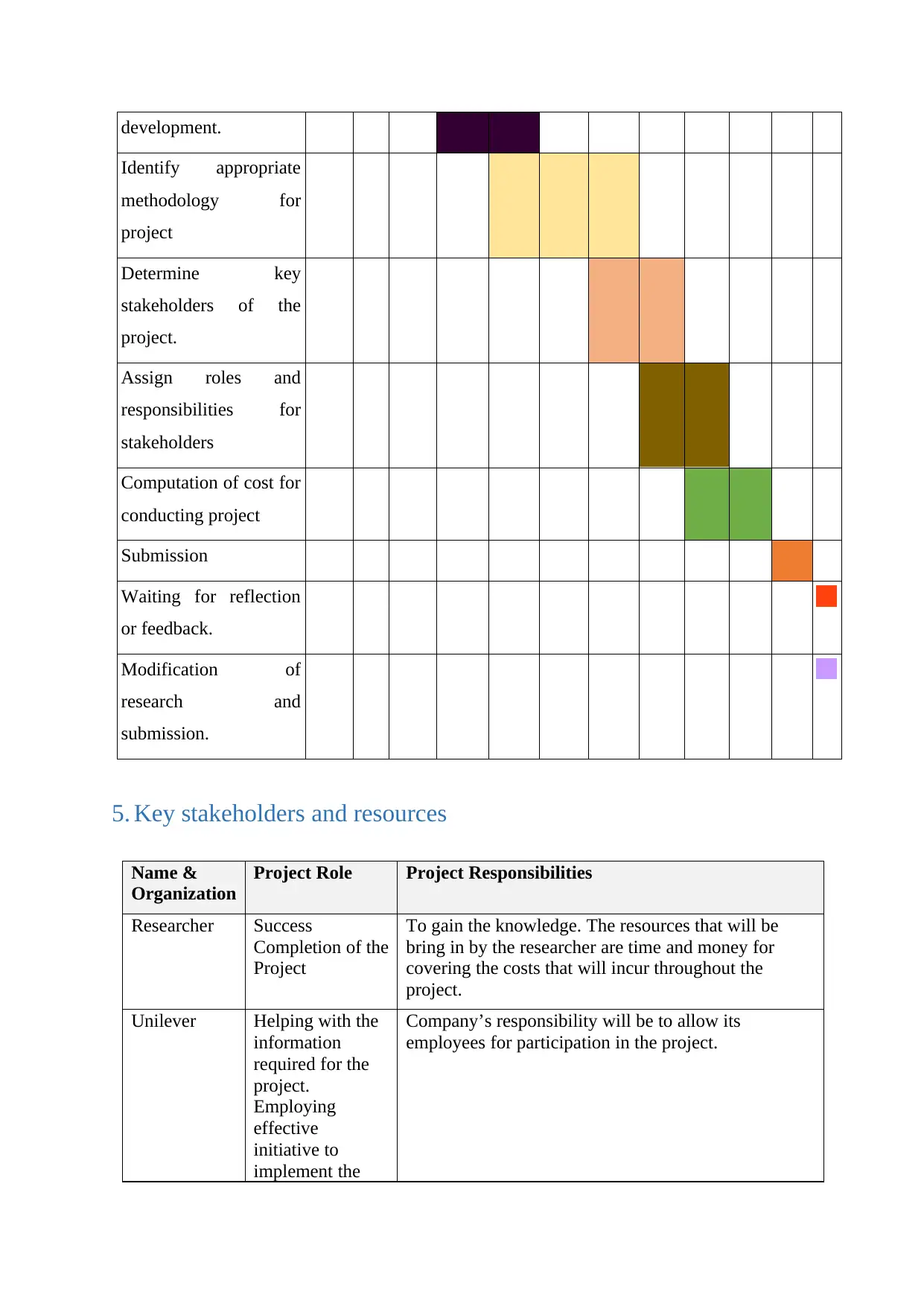
development.
Identify appropriate
methodology for
project
Determine key
stakeholders of the
project.
Assign roles and
responsibilities for
stakeholders
Computation of cost for
conducting project
Submission
Waiting for reflection
or feedback.
Modification of
research and
submission.
5. Key stakeholders and resources
Name &
Organization
Project Role Project Responsibilities
Researcher Success
Completion of the
Project
To gain the knowledge. The resources that will be
bring in by the researcher are time and money for
covering the costs that will incur throughout the
project.
Unilever Helping with the
information
required for the
project.
Employing
effective
initiative to
implement the
Company’s responsibility will be to allow its
employees for participation in the project.
Identify appropriate
methodology for
project
Determine key
stakeholders of the
project.
Assign roles and
responsibilities for
stakeholders
Computation of cost for
conducting project
Submission
Waiting for reflection
or feedback.
Modification of
research and
submission.
5. Key stakeholders and resources
Name &
Organization
Project Role Project Responsibilities
Researcher Success
Completion of the
Project
To gain the knowledge. The resources that will be
bring in by the researcher are time and money for
covering the costs that will incur throughout the
project.
Unilever Helping with the
information
required for the
project.
Employing
effective
initiative to
implement the
Company’s responsibility will be to allow its
employees for participation in the project.
Paraphrase This Document
Need a fresh take? Get an instant paraphrase of this document with our AI Paraphraser
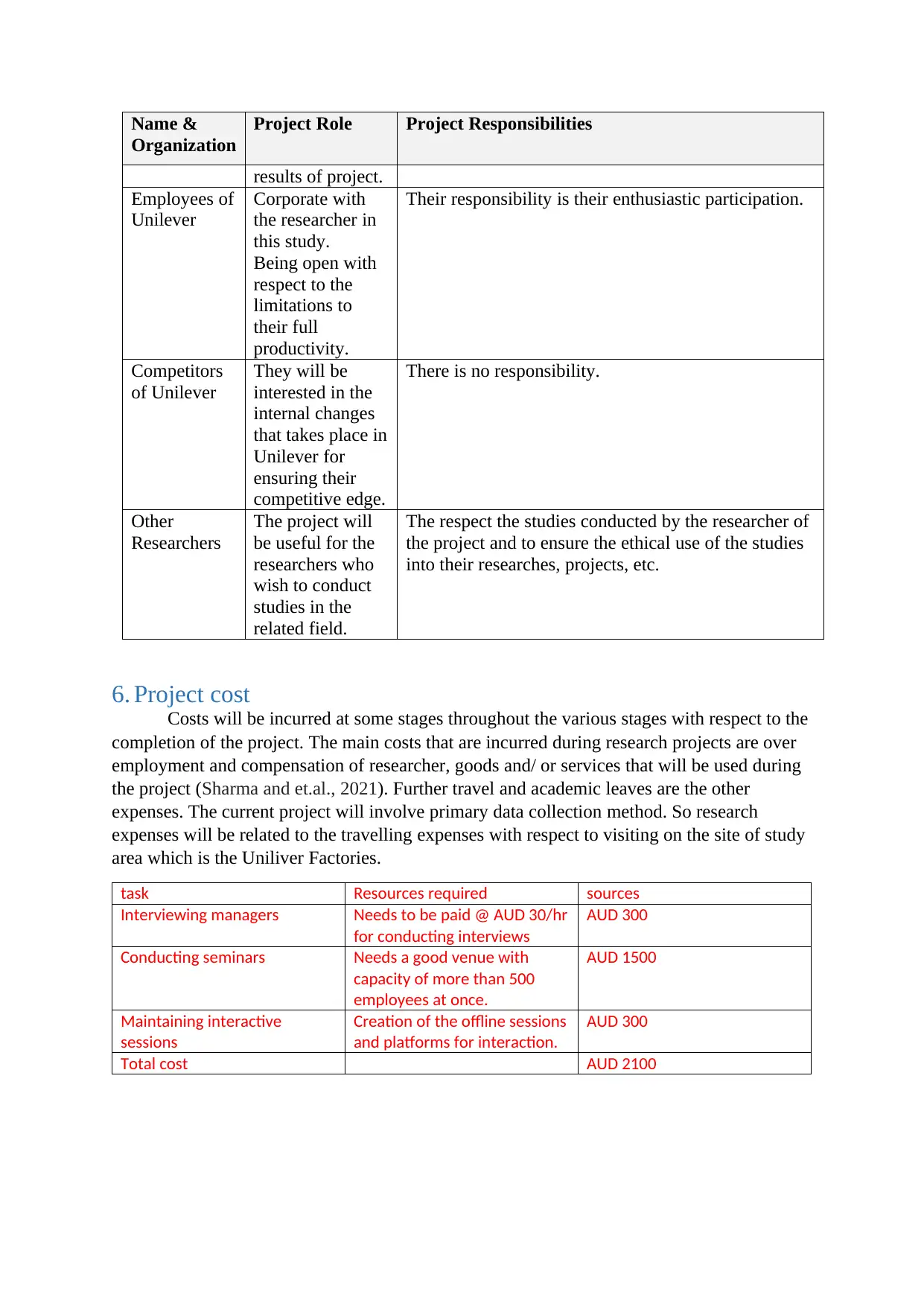
Name &
Organization
Project Role Project Responsibilities
results of project.
Employees of
Unilever
Corporate with
the researcher in
this study.
Being open with
respect to the
limitations to
their full
productivity.
Their responsibility is their enthusiastic participation.
Competitors
of Unilever
They will be
interested in the
internal changes
that takes place in
Unilever for
ensuring their
competitive edge.
There is no responsibility.
Other
Researchers
The project will
be useful for the
researchers who
wish to conduct
studies in the
related field.
The respect the studies conducted by the researcher of
the project and to ensure the ethical use of the studies
into their researches, projects, etc.
6. Project cost
Costs will be incurred at some stages throughout the various stages with respect to the
completion of the project. The main costs that are incurred during research projects are over
employment and compensation of researcher, goods and/ or services that will be used during
the project (Sharma and et.al., 2021). Further travel and academic leaves are the other
expenses. The current project will involve primary data collection method. So research
expenses will be related to the travelling expenses with respect to visiting on the site of study
area which is the Uniliver Factories.
task Resources required sources
Interviewing managers Needs to be paid @ AUD 30/hr
for conducting interviews
AUD 300
Conducting seminars Needs a good venue with
capacity of more than 500
employees at once.
AUD 1500
Maintaining interactive
sessions
Creation of the offline sessions
and platforms for interaction.
AUD 300
Total cost AUD 2100
Organization
Project Role Project Responsibilities
results of project.
Employees of
Unilever
Corporate with
the researcher in
this study.
Being open with
respect to the
limitations to
their full
productivity.
Their responsibility is their enthusiastic participation.
Competitors
of Unilever
They will be
interested in the
internal changes
that takes place in
Unilever for
ensuring their
competitive edge.
There is no responsibility.
Other
Researchers
The project will
be useful for the
researchers who
wish to conduct
studies in the
related field.
The respect the studies conducted by the researcher of
the project and to ensure the ethical use of the studies
into their researches, projects, etc.
6. Project cost
Costs will be incurred at some stages throughout the various stages with respect to the
completion of the project. The main costs that are incurred during research projects are over
employment and compensation of researcher, goods and/ or services that will be used during
the project (Sharma and et.al., 2021). Further travel and academic leaves are the other
expenses. The current project will involve primary data collection method. So research
expenses will be related to the travelling expenses with respect to visiting on the site of study
area which is the Uniliver Factories.
task Resources required sources
Interviewing managers Needs to be paid @ AUD 30/hr
for conducting interviews
AUD 300
Conducting seminars Needs a good venue with
capacity of more than 500
employees at once.
AUD 1500
Maintaining interactive
sessions
Creation of the offline sessions
and platforms for interaction.
AUD 300
Total cost AUD 2100
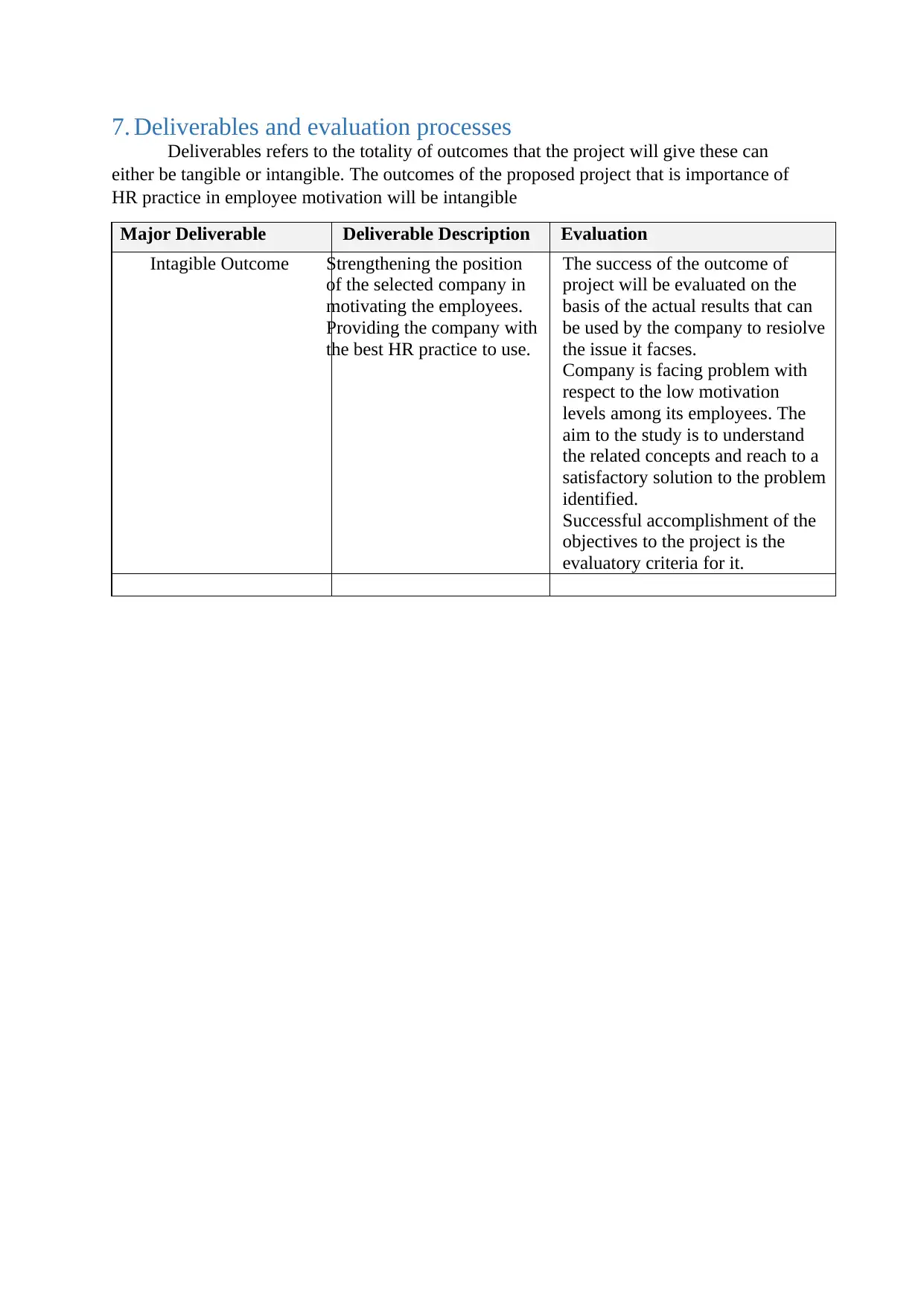
7. Deliverables and evaluation processes
Deliverables refers to the totality of outcomes that the project will give these can
either be tangible or intangible. The outcomes of the proposed project that is importance of
HR practice in employee motivation will be intangible
Major Deliverable Deliverable Description Evaluation
Intagible Outcome Strengthening the position
of the selected company in
motivating the employees.
Providing the company with
the best HR practice to use.
The success of the outcome of
project will be evaluated on the
basis of the actual results that can
be used by the company to resiolve
the issue it facses.
Company is facing problem with
respect to the low motivation
levels among its employees. The
aim to the study is to understand
the related concepts and reach to a
satisfactory solution to the problem
identified.
Successful accomplishment of the
objectives to the project is the
evaluatory criteria for it.
Deliverables refers to the totality of outcomes that the project will give these can
either be tangible or intangible. The outcomes of the proposed project that is importance of
HR practice in employee motivation will be intangible
Major Deliverable Deliverable Description Evaluation
Intagible Outcome Strengthening the position
of the selected company in
motivating the employees.
Providing the company with
the best HR practice to use.
The success of the outcome of
project will be evaluated on the
basis of the actual results that can
be used by the company to resiolve
the issue it facses.
Company is facing problem with
respect to the low motivation
levels among its employees. The
aim to the study is to understand
the related concepts and reach to a
satisfactory solution to the problem
identified.
Successful accomplishment of the
objectives to the project is the
evaluatory criteria for it.
⊘ This is a preview!⊘
Do you want full access?
Subscribe today to unlock all pages.

Trusted by 1+ million students worldwide

References
Ahmed, M. and et.al., 2021. Do green HR practices enhance green motivation and proactive
environmental management maturity in hotel industry?. International Journal of
Hospitality Management. 94. p.102852.
Beltrán-Martín, I. and Bou-Llusar, J.C., 2018. Examining the intermediate role of employee
abilities, motivation and opportunities to participate in the relationship between HR
bundles and employee performance. BRQ Business Research Quarterly. 21(2). pp.99-
110.
Dźwigoł, H. and Dźwigoł-Barosz, M., 2018. Scientific research methodology in management
sciences. Financial and credit activity problems of theory and practice. 2(25). pp.424-
437.
Lin, C., Li, X. and Lam, L.W., 2020. Development or maintenance? Dual‐oriented human
resource system, employee achievement motivation, and work well‐being. Human
Resource Management. 59(4). pp.311-325.
Mohajan, H.K., 2018. Qualitative research methodology in social sciences and related
subjects. Journal of Economic Development, Environment and People. 7(1). pp.23-48.
Newman, M. and Gough, D., 2020. Systematic reviews in educational research:
Methodology, perspectives and application. Systematic reviews in educational
research, pp.3-22.
Pandey, P. and Pandey, M.M., 2021. Research methodology tools and techniques. Bridge
Center.
Sharma, S. and et.al., 2021. A survey on applications of artificial intelligence for Pre-
Parametric Project Cost and Soil Shear-Strength estimation in construction and
geotechnical engineering. Sensors. 21(2). p.463.
Appendix
Ahmed, M. and et.al., 2021. Do green HR practices enhance green motivation and proactive
environmental management maturity in hotel industry?. International Journal of
Hospitality Management. 94. p.102852.
Beltrán-Martín, I. and Bou-Llusar, J.C., 2018. Examining the intermediate role of employee
abilities, motivation and opportunities to participate in the relationship between HR
bundles and employee performance. BRQ Business Research Quarterly. 21(2). pp.99-
110.
Dźwigoł, H. and Dźwigoł-Barosz, M., 2018. Scientific research methodology in management
sciences. Financial and credit activity problems of theory and practice. 2(25). pp.424-
437.
Lin, C., Li, X. and Lam, L.W., 2020. Development or maintenance? Dual‐oriented human
resource system, employee achievement motivation, and work well‐being. Human
Resource Management. 59(4). pp.311-325.
Mohajan, H.K., 2018. Qualitative research methodology in social sciences and related
subjects. Journal of Economic Development, Environment and People. 7(1). pp.23-48.
Newman, M. and Gough, D., 2020. Systematic reviews in educational research:
Methodology, perspectives and application. Systematic reviews in educational
research, pp.3-22.
Pandey, P. and Pandey, M.M., 2021. Research methodology tools and techniques. Bridge
Center.
Sharma, S. and et.al., 2021. A survey on applications of artificial intelligence for Pre-
Parametric Project Cost and Soil Shear-Strength estimation in construction and
geotechnical engineering. Sensors. 21(2). p.463.
Appendix
1 out of 10
Related Documents
Your All-in-One AI-Powered Toolkit for Academic Success.
+13062052269
info@desklib.com
Available 24*7 on WhatsApp / Email
![[object Object]](/_next/static/media/star-bottom.7253800d.svg)
Unlock your academic potential
Copyright © 2020–2025 A2Z Services. All Rights Reserved. Developed and managed by ZUCOL.





